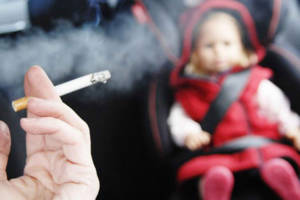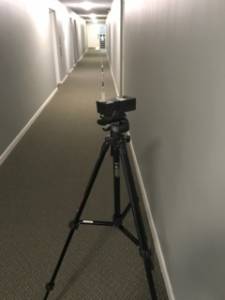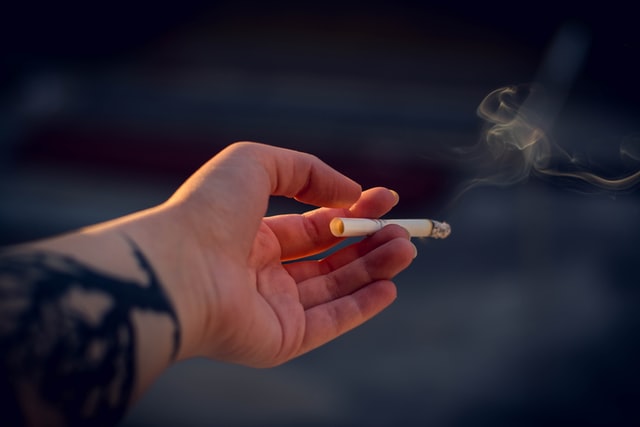Inhaling secondhand tobacco smoke indoors can seriously damage your health, particularly if you’re subjected to chronic smoke exposure. In fact, side stream smoke (the smoke that’s emitted by the burning end of a cigarette) can be more toxic than the filtered smoke that’s directly inhaled by smokers. It contains very high concentrations of the over 4000 chemicals found in cigarette smoke (at least 250 of which are known to cause disease).

Indoor Secondhand Tobacco Smoke
While secondhand smoke is harmful anywhere, it’s particularly dangerous when confined to indoor environments, such as homes and offices. This is the case because these spaces do not allow the smoke to disperse; instead, it lingers in the air for hours, even after just one cigarette has been burned. This puts the spouses and children of smokers at very high risk of health problems related to second hand smoke inhalation.
What Are the Risks of Secondhand Tobacco Smoke Exposure?
Decades of research conducted by health experts has linked secondhand tobacco smoke exposure to an increased risk of all of the following health problems:
- Heart disease. While most people associate cigarette smoke primarily with an increased risk of lung cancer, heart disease is actually the number one cause of death among active smokers. When a person inhales tobacco smoke, his or her heart rate increases while the blood vessels constrict, this places a lot of stress on the heart and cardiovascular system. Smoking also thickens the blood, damages the blood vessels, and raises cholesterol levels. Unfortunately, breathing in secondhand tobacco smoke has been shown to produce similar effects in nonsmokers. According to the US Surgeon General, living or working in an indoor environment where smoking is allowed increases a nonsmokers’ risk of developing heart disease by 25–30%.
- Stroke. Because of the aforementioned damage to blood vessels and increase in blood pressure that secondhand smoke exposure causes, regular inhalation of secondhand tobacco smoke can dramatically increase a person’s risk of stroke. According to a study published in the American Journal of Preventive Medicine, frequent exposure to secondhand smoke can raise a person’s stroke risk by 30%.
- Cancer. In addition to raising the risk of lung cancer by 20-30%, exposure to secondhand smoke may increase a person’s risk of developing other tobacco related cancers, such as bladder cancer, pancreatic cancer, and even aggressive skin cancer.
- Asthma. While secondhand smoke does not directly cause asthma, it can make a person’s asthma symptoms far more severe—even life threatening. Severe asthma symptoms are particularly likely when the asthmatic being exposed to secondhand tobacco smoke is a young child.
- Susceptibility to infection. Tobacco smoke exposure is thought to have a detrimental effect on the immune system, as well as being a respiratory irritant. Those who are exposed to secondhand smoke regularly are therefore more likely to develop bronchitis, ear infections, pneumonia, and other upper respiratory infections. Once again, the risk of developing these health issues dramatically increases when the person being exposed to secondhand smoke is a child. The elderly may also be more susceptible to these ill effects.
- Sudden death in infants. Exposure to the chemicals in tobacco smoke, either while in the womb or in the home, can have a devastating effect on the health of infants. In extreme cases, babies have suffered from Sudden Infant Death Syndrome (SIDS) after being exposed to tobacco smoke. As the name of this syndrome suggests, these infants die suddenly and apparently inexplicably, after appearing healthy just hours prior.
What Can You Do to Limit the Harmful Effects of Secondhand Smoke?
The best way to limit the harmful effects of secondhand smoke is to avoid people who are smoking. If this is not possible—i.e., you live with people who refuse to smoke outdoors—the best thing you can do to safeguard your health is improve the ventilation in your home. Consult an indoor air expert for assistance; he or she will be able to advise you on the various steps you can take to prevent smoky air from entering your room. Simple solutions, such as installing high-quality HEPA air filters and circulating outdoor air throughout your room, can help to reduce your total exposure to secondhand smoke.
IndoorDoctor performs specialized tests and air samples to confirm the presence of indoor secondhand tobacco smoke.







